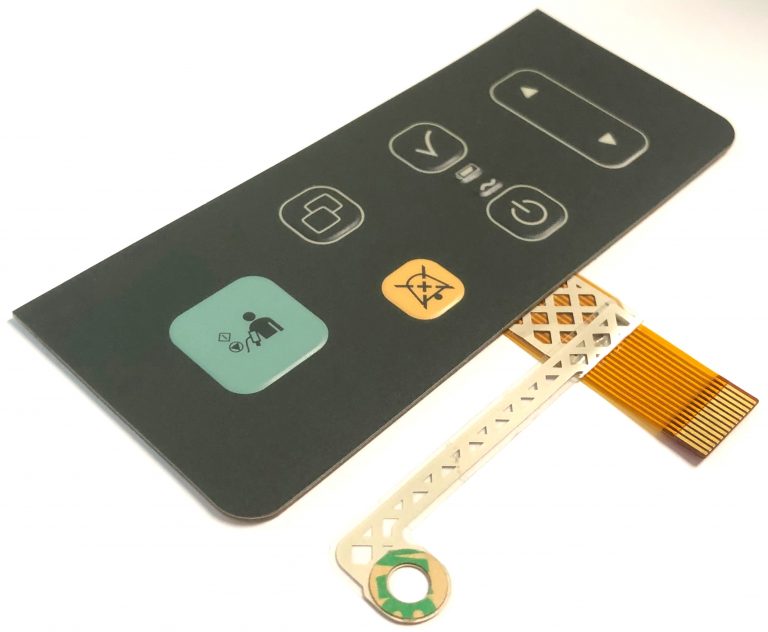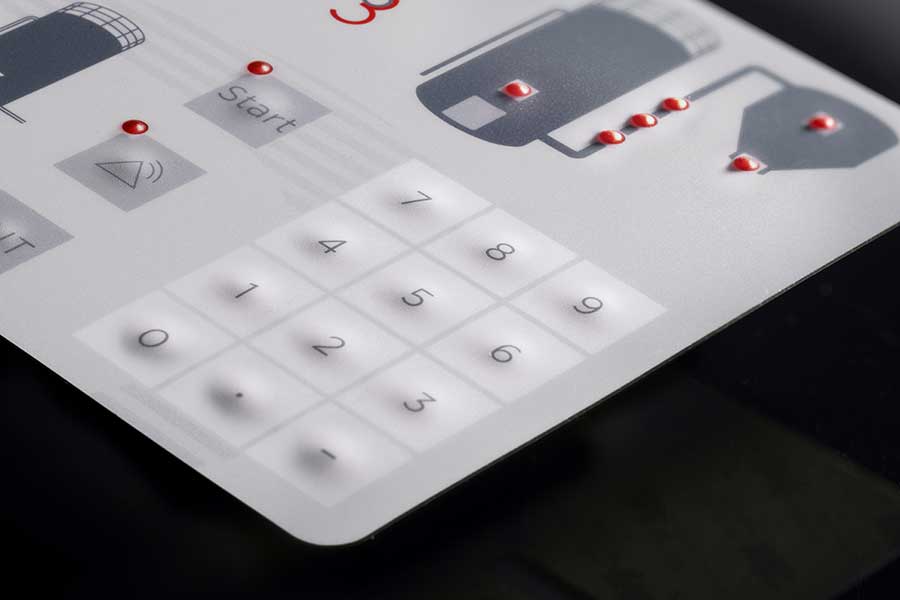Projects requiring accuracy should always involve a experienced membrane switch manufacturer from the start.
Projects requiring accuracy should always involve a experienced membrane switch manufacturer from the start.
Blog Article
All About Membrane Change: Comprehending Its Layout and Functionality
When you assume regarding the control user interfaces in modern devices, membrane buttons typically enter your mind. These components are greater than just switches; they blend style and performance seamlessly. Recognizing just how they work and what makes them efficient can alter your point of view on day-to-day electronic devices. There are subtleties to their style and performance that you may not be aware of. Allow's discover what collections membrane layer switches over besides various other control systems.
What Are Membrane Switches?

Their smooth nature makes them easy to clean and resistant to dust and wetness, an important attribute in numerous environments. Membrane layer switches can additionally be tailored relating to form, dimension, and graphics, allowing suppliers to develop one-of-a-kind interfaces customized to details items. And also, they're lightweight and thin, which aids in lessening the overall mass of devices. In general, membrane buttons play a substantial function in boosting user experience throughout a broad array of applications.
Just How Membrane Layer Switches Over Job
When you press a secret on a membrane layer button, it triggers a simple yet effective system. The top layer, typically constructed from flexible material, presses down onto a conductive layer below it. This action bridges the space in between conductive traces, completing an electrical circuit. As quickly as the circuit closes, it sends out a signal to the gadget's controller, which interprets your input.
You'll discover that the tactile responses differs based upon the button design, providing either a soft click or a much more pronounced feedback. As soon as you launch the key, the membrane returns to its original setting, resuming the circuit and quiting the signal. This procedure happens nearly instantly, making sure a receptive user experience.
Membrane layer switches are popular because of their toughness and resistance to dust and wetness, making them optimal for numerous applications, from house appliances to medical devices. Understanding this procedure aids you value their prevalent use.
Trick Parts of Membrane Buttons
Recognizing the crucial components of membrane buttons is fundamental for comprehending their functionality and style. At the core, you'll locate the graphic overlay, which gives the visual user interface for customers. Underneath that, there's a spacer layer that divides the circuit layers, making certain that they do not make get in touch with up until pressed. The circuit layer is where the magic happens; it contains conductive traces that complete the circuit when you press the button. An additional vital element is the adhesive support, permitting the switch to abide by surfaces firmly. The protective layer shields versus environmental variables and use, prolonging the switch's life-span. Each element plays a significant function in making sure trusted efficiency and individual communication. By recognizing these components, you'll get understanding right into how membrane switches over run and their relevance in various applications.
Materials Utilized in Membrane Switch Over Style
The efficiency and longevity of membrane layer changes heavily rely on the materials utilized in their style. You commonly experience polyester and polycarbonate as primary substratums due to their excellent toughness and flexibility. These products resist scrapes and chemicals, making them excellent for requiring environments.
The conductive layers often make use of silver or carbon, picked for their integrity and conductivity. membrane switch manufacturer. Silver gives superior performance, while carbon is an economical choice. For the overlay, you might think about a matte or shiny coating, depending on your aesthetic requirements and user experience
Make particular to pick adhesives that endure ecological aspects like temperature level and humidity. Choosing the appropriate materials will assure your membrane switch stands the test of time.
Design Considerations for Membrane Switches
While creating membrane layer switches, it's essential to take into account numerous aspects that affect their performance and customer experience. Start by focusing on the design and switch size; make certain they're intuitive and very easy to browse.
Do not neglect the visuals design; clear labeling and shade contrast are considerable for presence. Verify your style fits ecological elements, like dampness or temperature variations, which could impact efficiency. Remember the value of screening prototypes with real customers to collect responses and make necessary modifications. This repetitive procedure aids you refine the design, validating it meets both practical and aesthetic needs effectively. By carefully thinking about these aspects, you'll develop a membrane layer button that enhances usability and fulfillment.
Applications of Membrane Layer Buttons
Membrane buttons are versatile components found in various applications, from industrial tools to consumer electronics. You'll see their impact in makers that call for resilient interfaces and in gadgets that gain from smooth layouts. Comprehending these applications helps you appreciate the functionality and usefulness of membrane switches in daily modern technology.
Industrial Equipment Use
When you're looking to improve the capability of commercial tools, membrane layer buttons offer a dependable remedy that integrates longevity with straightforward design. These buttons are ideal for rough atmospheres, providing resistance to dust, dampness, and chemicals. Accept membrane layer switches to enhance your operations and boost overall performance.
Consumer Electronics Assimilation
In the domain name of customer electronics, membrane buttons play a necessary duty in improving customer communication and tool capability. You'll locate them in devices like microwaves, remote controls, and pc gaming consoles, providing a seamless means to interact with technology. Their smooth design enables for easy assimilation into different items, making controls intuitive and user-friendly. With their capacity to incorporate graphics and backlighting, you can enjoy a modern-day aesthetic that matches the tool's overall look. Membrane layer switches likewise assure longevity and resistance to dirt and moisture, prolonging the life expectancy of your electronics. By choosing membrane switches, you boost not simply the performance yet also the design of your devices, making everyday interactions smooth and enjoyable.
Advantages and Downsides of Membrane Switches
While membrane layer buttons provide a series useful site of benefits, they additionally come with some disadvantages that you need to take into consideration. One substantial benefit is their compact style, making them suitable for space-constrained applications. They're likewise affordable, providing a resilient remedy with a low production expense. In addition, their smooth surface is simple to clean, improving hygiene in atmospheres like hospitals.

Nonetheless, there are drawbacks. Membrane switches can have a shorter life-span contrasted to mechanical buttons, particularly under heavy usage. They can also be much less responsive, which might influence individual responses throughout operation. In addition, if harmed, fixing them can be tough and often calls for full substitute. Inevitably, their level of sensitivity to extreme temperatures and environmental problems may restrict their performance in particular settings. Stabilizing these benefits and drawbacks will assist you determine if membrane layer switches are the ideal fit for your job.
Often Asked Concerns
The Length Of Time Do Membrane Changes Usually Last?
Membrane layer changes typically last between 5 to ten years, depending upon usage and environmental problems. You'll wish to evaluate factors like wear, direct exposure to moisture, and temperature changes to evaluate their long life effectively.
Can Membrane Layer Switches Over Be Personalized for Particular Layouts?
Yes, you can personalize membrane layer buttons to fit details styles (membrane switch manufacturer). You'll have the liberty to pick shades, forms, and useful site formats that match your project's needs, guaranteeing they blend flawlessly with your total aesthetic
What Is the Price Array for Membrane Switch Over Production?
The cost variety for membrane layer button manufacturing commonly drops between $1 and $10 per system, relying on variables like layout intricacy, amount, and materials. You can get quotes from suppliers to locate the most effective alternative.

Are Membrane Switches Water-proof or Immune?
Membrane buttons can be designed to be water resistant or immune, depending on materials utilized and construction techniques. If you require them for wet settings, ensure you specify those requirements click this site during the layout process.
How Do Membrane Changes Contrast to Conventional Buttons?
Membrane layer buttons are usually thinner and a lot more flexible than conventional switches, using a sleek style. They're typically less complicated to clean and incorporate, yet might not offer the tactile comments you're utilized to with mechanical choices.
Verdict

Report this page